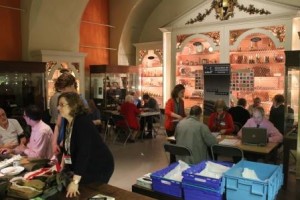Being placed in Oxford, RunCoCo are fortunate to have a number of excellent museums more or less on our doorstep. We do enjoy working with these when the opportunity arises. This summer we had the pleasure to be involved with the Museum of Oxford in their community collection of objects for their 40 years, 40 objects exhibition (see previous post). This autumn we were invited to the Museum of the History of Science to support their First World War community collection. The museum was running a series of events to tie in with their ‘Dear Harry’ exhibition, and decided to go with an idea we have had for a long time: running a community collection event in the Museum.
The History of Science Museum is based in the world’s oldest surviving purpose-built museum building which naturally poses some challenges when it comes to running an event which involves a large number of staff and visitors as well as digitisation equipment and computers. It is not only a question of finding the space for it all, making sure there is room and facilities to receive a potentially large number of visitors, but also the issue of how to incorporate the digital element. Seemingly simple matters like getting access to electric sockets pose a challenge in a 17th Century building. Luckily, the Museum team were able to meet the challenges and put on a very good event.
For RunCoCo, working with our local museums offers an opportunity to adapt our ideas about procedures and practices to different contexts. That in itself is not different from working with any organisation. What is different, however, is that working locally we can have a more immediate link to the physical space where an event is to take place, and we usually meet with the local team several times over a period of time. When we work with remote organisations, we communicate over email, phone, and online. If we meet, it is only for an intense planning and training session over a couple of days or less. Although that works very well, and offers the organiser an opportunity to focus on planning their event without distractions, it is interesting to also have the opportunity to work in a different way, engaging with the event organiser and their space over a longer period of time.
For the event at the Museum of History of Science, we first met with the organisers on a couple of occasions to discuss their ideas for the event and talk about how to make it all happen. We also provided two training sessions, one for event organisers and one for event volunteers. Although these were held in the Museum, they were open also to participants who were not involved in this particular event. This is part of the strategic plan to spread community collection expertise and encourage further collection initiatives. At the actual event, RunCoCo were there to lend a hand, and as it was a local event it was easy for the organisers to borrow some of our digitisation equipment.
The community collection day at the Museum of the History of Science went very well and both visitors and staff found it a rewarding experience. From RunCoCo’s side, the best feedback is to hear that the Museum may be thinking about doing it again. Next time they will not need our training and support but know exactly what to do and how to make it work for them. That is, of course, exactly how it should be, but I for one must admit that it will be hard to stay away if I hear that there will be another community collection event in one of our local museums. Where is the volunteer sign-up sheet, please?
The first Museum of the History of Science collection event was held on the 26th of September. The RunCoCo training sessions were supported by the Van Houten Bequest through the strategic funding for Oxford’s First World War Centenary

